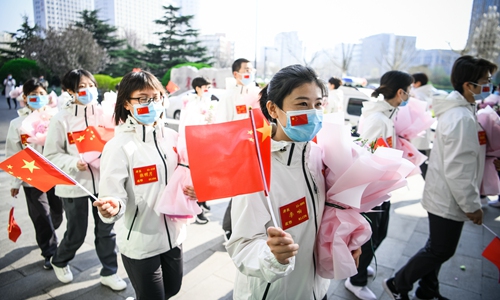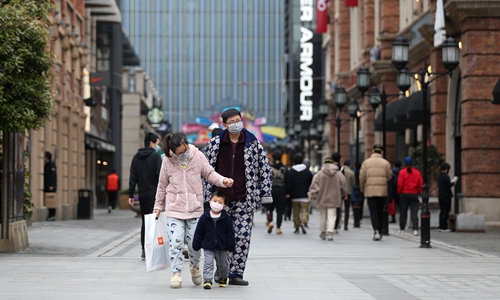HOME >> CHINA,SPECIAL-COVERAGE
Wuhan govt weighs whether to test all residents to find silent carriers
By Wan Lin and Liu Caiyu Source:Global Times Published: 2020/4/3 0:48:40 Last Updated: 2020/4/3 9:21:21
2nd outbreak caused by silent carriers unlikely: expert

A 216-strong medical team is released from a 14-day quarantine in Tianjin on Thursday after returning from Hubei Province where they helped combat the coronavirus outbreak. Photo: cnsphoto
Wuhan authorities are studying whether the government should test all residents to find asymptomatic COVID-19 carriers amid public worry over a second outbreak.
The announcement was in response to a proposal posted on the online Message Board for Leaders run by news website people.cn. The proposal from an anomymous netizen suggested that Wang Zhonglin, Wuhan's Party chief, should offer free nucleic acid testing to all residents, some 11 million people. The online message board was started to gather netizen advice and questions during the epidemic.
The post received a reply on Tuesday, saying that the request has been refered to relevant departments for discussion.
Recently reported cases of asymptomatic COVID-19 carriers have sparked public concern over whether the contagious novel coronavirus would trigger a second outbreak.
To address the public concern, China began publishing details of asymptomatic COVID-19 carriers on Wednesday. The number of new asymptomatic cases came out on Wednesday and Thursday were 130 and 55 respectively. Currently, there are 1,075 asymptomatic patients under medical observation in the Chinese mainland, including 721 from Hubei Province.
The number is within the estimated parameters of Chinese epidemiologists. Yang Zhanqiu, a Wuhan-based virologist, said that although the number of asymptomatic patients is not representative of the country's whole situation, it is helpful for the further tracing and monitoring of people who had close contact with silent carriers.
The number of newly reported asymptotic patients will likely reduce in the next two weeks as some will become confirmed cases, while those with no symptoms will be cleared after completing the quarantine period , said Wang Peiyu, deputy head of Peking University's school of public health.
The infectiousness of asymptomatic patients is equivalent to one-third of confirmed COVID-19 patients, who will infect on average three people. Asymptomatic carriers will infect less than one person. The number of patients who were infected by asymptomatic carriers only accounted for 4.4 percent of the total number of patients, said Wu Zunyou, an epidemiologist from at the Chinese Center for Disease Control and Prevention, at Thursday's press conference.
It means that asymptomatic carriers have limited impact on the spread of the epidemic, Wu said.
A survey conducted in a province in South China showed that among more than 1,500 people who had close contact with silent virus carriers, only seven were confirmed to be infected. Further investigation showed that the seven had contact with both asymptomatic and confirmed cases, Wu said.
It indicates that their infection may not be caused by silent virus carriers, he noted.

A family in Wuhan walk on a shopping street. Photo: Cui Meng/GT
Current data on the infectious period and transmission capacity of asymptomatic patients is still limited, and this needs further observation and research, he noted.
Wu stressed that all asymptomatic carriers must either have a history of contact with a confirmed patient, or they have been to the epidemic area. It is unlikely to see silent carriers in places where confirmed cases have been cleared for more than two weeks, he said.
"Our current measures are able to detect and control asymptomatic patients in time," he said. "The possibility of an outbreak caused by asymptomatic patients is very slight and these patients will not cause social spread," he said.
Top Chinese epidemiologist Zhong Nanshan warned that more attention should be paid to two categories of asymptomatic patients: those who have been in close contact with infected patients and those who have recently come from outbreak areas. Zhong shared this information during a remote video international conference on epidemic prevention and control on Thursday.
At Thursday's meeting of the central government's leading working group on combating COVID-19, officials called for scientific epidemiological investigations of asymptomatic patients as well as the strengthening of the reporting, quarantining, and medical management of these patients. They requested local governments not to hide or misreport the situation.
Experts noted that testing all residents in Wuhan is costly and unnecessary, suggesting the government should test high-risk groups.
Those at high-risk include medical staff and their families, patients' families, volunteers and journalists in Wuhan, Peng Zhiyong, director of the intensive care unit of the Zhongnan Hospital of Wuhan University in Wuhan, told the Global Times on Thursday.
Wang said that "some asymptomatic virus carriers from Wuhan may have very strong antibodies and the virus won't harm them, but it can still transmit to people who have no antibodies."
A large-scale sampling test should be conducted in Wuhan to prevent asymptomatic carriers from spreading the virus to other places, especially as China is gradually resuming work and production, Wang said.
Newspaper headline: Wuhan weighs tests for all
Posted in: SOCIETY,FOCUS